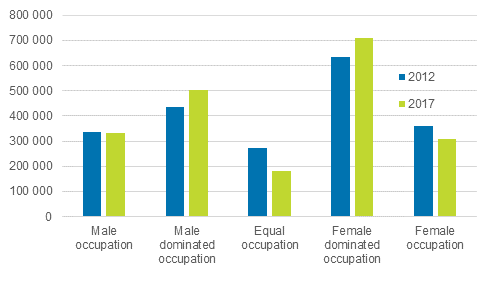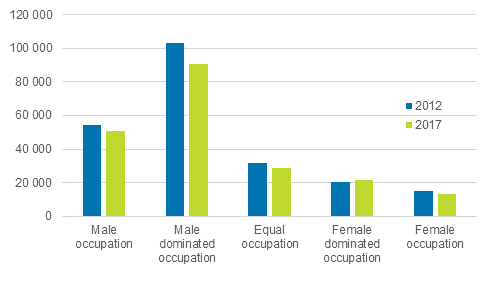2. Professional differentiation among wage and salary earners and entrepreneurs in 2017 and 2012
The share of wage and salary earners working in equal occupations among all wage and salary earners was ten per cent in 2017 and had dropped by five percentage points over five years. The share of entrepreneurs working in equal occupations was 14 per cent, which remained unchanged from 2012.
Figure 1. Number of wage and salary earners in various segregation classes in 2012 and 2017

Professional differentiation by sex, segregation, is based on the classification of occupational groups by gender proportions. The strength of the segregation is determined based on how many persons work in equal occupational groups.
Table 1. 5-class segregation classification of occupations
| Segregation class | The occupational groups in which |
| Female occupation | women > 90 % |
| Female-dominated occupation | 60 % < share of women <= 90 % |
| Equal occupation | 40 % <= share of women / men <= 60 % |
| Male-dominated occupation | 60 % < share of men <= 90 % |
| Male occupation | men > 90 % |
Occupational segregation among wage and salary earners and entrepreneurs was examined based on the 5-digit level of the Classification of Occupations 2010.
2.1 Share of wage and salary earners working in equal occupations has fallen by five percentage points in five years
In 2017, 8.9 per cent of all wage and salary earners were in so-called equal occupational groups, where the share of different sexes among those included in the occupational group is 40 to 60 per cent. The share of wage and salary earners working in equal occupations among all wage and salary earners (excl. Occupational data missing) was about five percentage points lower in 2017 than in 2012.
For example, the following occupational groups had been removed from equal occupations of wage and salary earners over five years: commercial sales representatives (37,400), administration and trade development professionals (16,300) and mail carriers (10 000). In total, 92,900 persons and 25 occupational groups were removed from equal occupations of wage and salary earners in five years. Only 14,700 wage and salary earners were working in occupations that have become more even by their gender distribution and some 15 occupational groups of equal occupations came into being. The biggest occupational groups that have become equal occupational groups were management and organisation analysts (6,300 persons), building construction architects (3,200 persons) and legal professionals not elsewhere classified (2,200 persons).
For wage and salary earners, the most evenly divided occupational groups in 2017 were farm relief workers (4,200 persons in total of whom 49.9 per cent women and 50.1 per cent men), advertising and public relations managers (1,100 persons in total of whom 50.5 per cent women and 49.5 per cent men), and livestock workers (2,500 persons in total of whom 50.5 per cent women and 49.5 per cent men).
In 2017, wage and salary earners' most common equal occupational groups were food and related products machine operators (14,700 persons), advertising and marketing professionals (14,500 persons) and vocational education teachers (13,200 persons).
Table 2. Wage and salary earners aged 18 to 74 in segregation classes in 2017 1)
| Segregation class | Wage and salary earners | Share of wage and salary earners, % | Women | Share of women, % | Men | Share of men, % |
| Female occupation | 306,592 | 15.1 | 287,041 | 27.3 | 19,551 | 2.0 |
| Female dominated occupation | 710,484 | 35.0 | 535,677 | 50.9 | 174,807 | 17.8 |
| Equal occupation | 181,536 | 8.9 | 93,199 | 8.9 | 88,337 | 9.0 |
| Male dominated occupation | 502,364 | 24.7 | 119,216 | 11.3 | 383,148 | 39.1 |
| Male occupation | 331,609 | 16.3 | 16,690 | 1.6 | 314,919 | 32.1 |
| Total | 2,032,585 | 100.0 | 1,051,823 | 100.0 | 980,762 | 100.0 |
2.2 Share of entrepreneurs working in equal occupations among all entrepreneurs has grown
In 2017, a total of 14 per cent of all entrepreneurs were in equal occupations, where the share of different sexes among those included in the occupational groups is 40 to 60 per cent. The share of entrepreneurs working in equal occupations among all entrepreneurs in 2017(excl. occupational data missing) did not change from 2012. The examination disregards the fact that women's share of all entrepreneurs was only 34 per cent.
Figure 2. Number of entrepreneurs in various segregation classes in 2012 and 2017

For entrepreneurs, occupational groups that have become equal occupations in five years were such as gardeners, horticultural and nursery growers (1,100 persons) and stall and market salespersons (500 persons). The biggest of the removed equal occupational groups was visual artists (400 persons). In five years, 1,900 entrepreneurs came to equal occupations and around 1,600 were removed from there.
For entrepreneurs, the most evenly divided occupational groups were, e.g. gallery, museum and library technicians (around 60 persons in total of whom 50.0 per cent women and 50.0 per cent men), philosophers, historians and political scientists (110 persons in total of whom 50.0 per cent women and 50 per cent men), domestic housekeepers (450 persons in total of whom 50.1 per cent women and 49.9 per cent men), and .medical practitioners (450 persons in total of whom 48.9 per cent women and 51.1 per cent men.
In 2017, the most common equal occupational groups of entrepreneurs were shop keepers (small entrepreneurs) (9,400 persons), restaurant services supervisors and shift managers (4,300 persons) and fitness and recreation instructors and program leaders (2,300 persons).
Table 3. Entrepreneurs aged 18 to 74 in segregation classes in 2017 1)
| Segregation class | Entrepreneurs | Share of entrepreneurs, % | Women | Share of women, % | Men | Share of men, % |
| Female occupation | 13,384 | 6.5 | 12,640 | 18.8 | 744 | 0.5 |
| Female dominated occupation | 21,508 | 10.5 | 15,086 | 22.5 | 6,422 | 4.6 |
| Equal occupation | 29,196 | 14.2 | 13,781 | 20.5 | 15,415 | 11.1 |
| Male dominated occupation | 90,463 | 44.0 | 22,748 | 33.9 | 67,715 | 48.9 |
| Male occupation | 50,953 | 24.8 | 2,847 | 4.2 | 48,106 | 34.8 |
| Total | 205,504 | 100.0 | 67,102 | 100.0 | 138,402 | 100.0 |
Source: Employment Statistics, Statistics Finland
Inquiries: Elina Mikkelš 029 551 2973, Juho Keva 029 551 3601, info@stat.fi
Director in charge: Jari Tarkoma
Updated 01.11.2019
Official Statistics of Finland (OSF):
Employment [e-publication].
ISSN=2323-6825. Industry, employer sector and jobs 2017,
2. Professional differentiation among wage and salary earners and entrepreneurs in 2017 and 2012
. Helsinki: Statistics Finland [referred: 16.12.2025].
Access method: http://stat.fi/til/tyokay/2017/04/tyokay_2017_04_2019-11-01_kat_002_en.html

